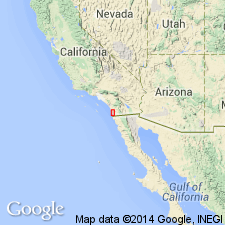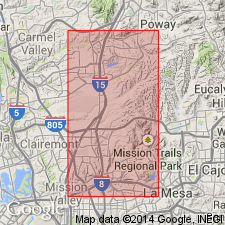
- Usage in publication:
-
- Mission Valley Formation*
- Modifications:
-
- Named
- Biostratigraphic dating
- Dominant lithology:
-
- Sandstone
- AAPG geologic province:
-
- Peninsular Ranges province
Summary:
Named as upper formation (of 2) of Poway Group for exposure along Mission Valley in San Diego. Type section designated along south wall of valley on west side of HWY 163 (old 395) at its junction with HWY I-8 [La Jolla 7.5'x10' quad] San Diego Co, CA. Extends to Rancho Bernardo, about 30 km to north. Rocks were included within Poway Conglomerate. Composed of friable, light-olive-gray, fine-grained sandstone containing several concretionary layers with molluscan fossils and grayish-red sandstone layers near middle part. Conformably overlies Stadium Conglomerate (new) of Poway Group. At type conformably underlies unnamed nonmarine cobble-conglomerate layer that belongs to Poway Group. Age is late Eocene based on mollusks identified by C.R. Givens (written commun., 1970).
Source: GNU records (USGS DDS-6; Menlo GNULEX).

- Usage in publication:
-
- Mission Valley Formation*
- Modifications:
-
- Age modified
- Biostratigraphic dating
- AAPG geologic province:
-
- Peninsular Ranges province
Summary:
Age of Mission Valley Formation is middle Eocene based on pollen and spores from six samples taken from unit.
Source: GNU records (USGS DDS-6; Menlo GNULEX).
For more information, please contact Nancy Stamm, Geologic Names Committee Secretary.
Asterisk (*) indicates published by U.S. Geological Survey authors.
"No current usage" (†) implies that a name has been abandoned or has fallen into disuse. Former usage and, if known, replacement name given in parentheses ( ).
Slash (/) indicates name conflicts with nomenclatural guidelines (CSN, 1933; ACSN, 1961, 1970; NACSN, 1983, 2005, 2021). May be explained within brackets ([ ]).

